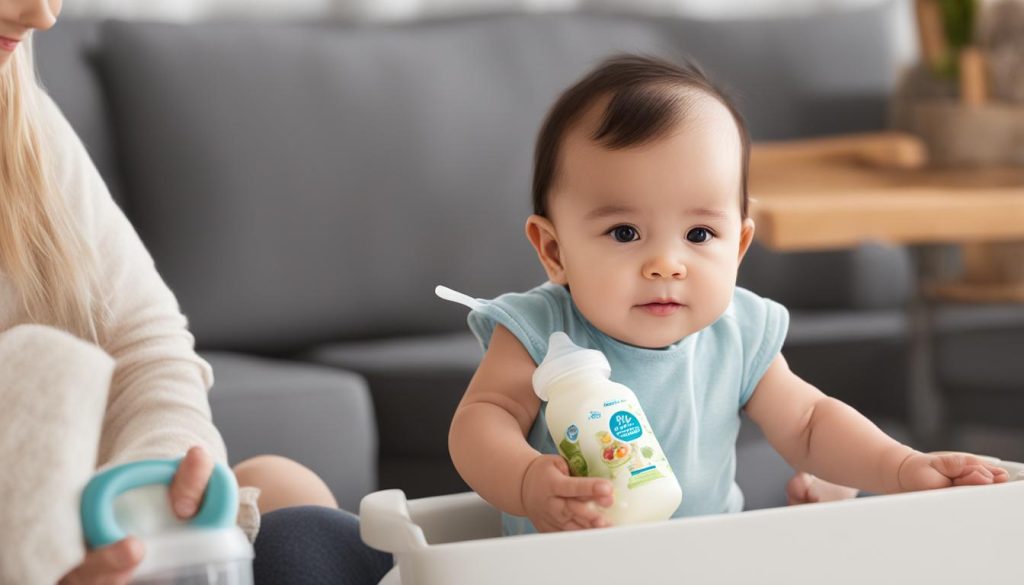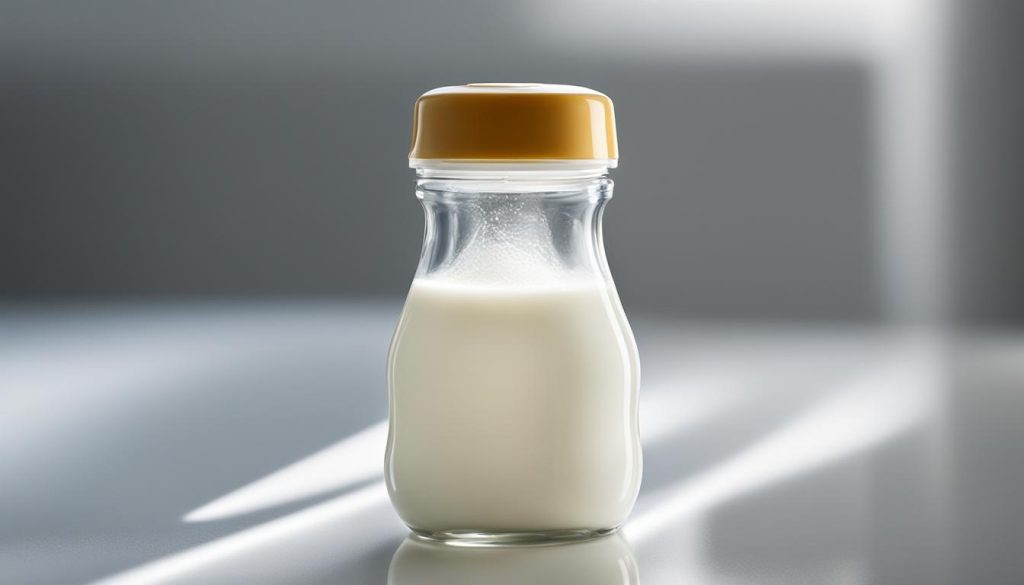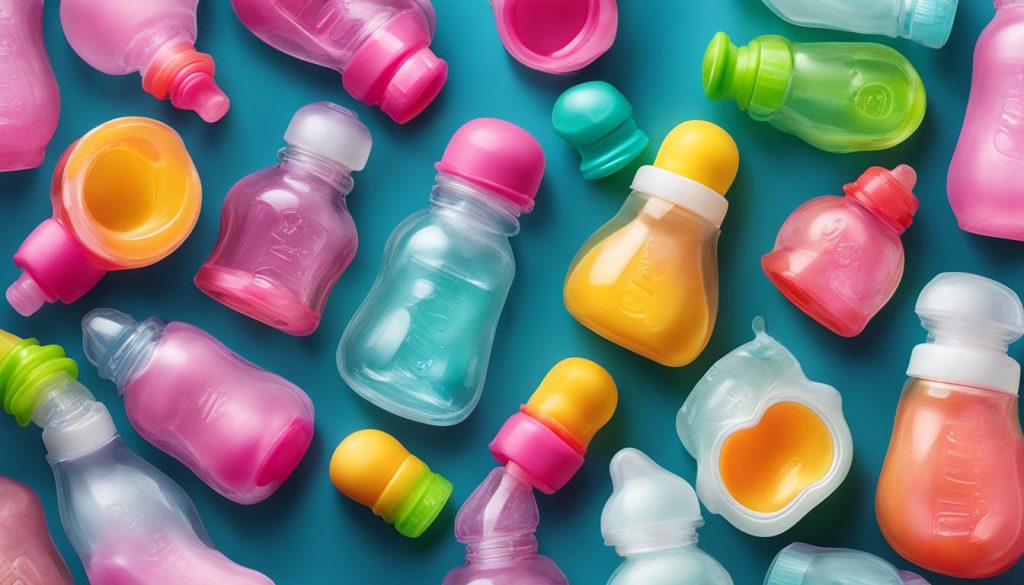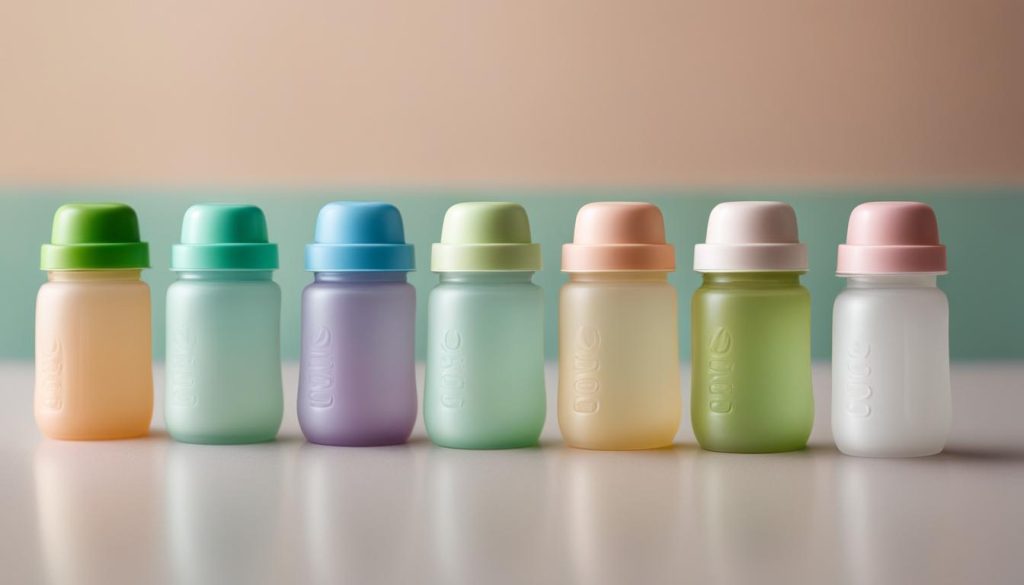After extensive research and testing, I have found the best milk bottle for 1-year-olds. When choosing a bottle for your little one, it’s important to consider factors such as durability, convenience, and safety. The top-rated milk bottle for toddlers that meets all these criteria is the Comotomo Baby Bottle.
The Comotomo Baby Bottle is ergonomically designed to make feeding easier for both you and your child. It features a squishy silicone material that mimics the feel of breastfeeding, helping to facilitate a smooth transition from breast to bottle. The wide-neck design allows for easy pouring and cleaning, making it an easy-to-clean milk bottle for toddlers.
One of the standout features of the Comotomo Baby Bottle is its leak-proof design. This ensures that you won’t have to worry about any messy spills or leaks while on the go. Additionally, the bottle is made from BPA-free materials, providing a safe and convenient milk bottle for one-year-olds.
For newborns or premature babies, I recommend Dr. Brown’s Natural Flow Original Baby Bottle. It offers a variety of nipple sizes to accommodate your baby’s needs and promotes a natural feeding experience.
When it comes to choosing the best milk bottle for your 1-year-old, the Comotomo Baby Bottle and Dr. Brown’s Natural Flow Original Baby Bottle are the top contenders. Consider your child’s unique needs and preferences when making your decision, and rest assured knowing that both options provide a safe and reliable feeding experience.
Types of Baby Bottles
When it comes to choosing a milk bottle for your 1-year-old, there are several types of baby bottles to consider. Each type has its own unique features and benefits, so it’s important to understand the options available.
Glass Baby Bottles
Glass baby bottles are a popular choice for parents who prioritize safety and want to avoid potential chemical leaching from plastic bottles. They are made from sturdy, BPA-free glass that is easy to clean and sterilize. Glass bottles are also known for their durability and long lifespan, making them a sustainable choice for eco-conscious parents.
Plastic Baby Bottles
Plastic baby bottles are lightweight and less prone to breaking, making them an excellent option for parents looking for a bottle that is easy for their little one to hold. However, it’s important to choose bottles that are made from high-quality, BPA-free plastic to ensure the safety of your child.
Silicone Baby Bottles
Silicone baby bottles offer a soft and flexible material that is easy to clean and maintain. They are also lightweight, making them a great choice for on-the-go parents. Additionally, silicone bottles are durable and resistant to heat, making them suitable for both refrigeration and sterilization.
When deciding on the type of baby bottle to use, consider factors such as your child’s preferences, your lifestyle, and any specific concerns you may have. Ultimately, the most important thing is to choose a bottle that is safe, convenient, and suitable for your 1-year-old’s needs.
Table: Comparison of Baby Bottle Types
| Type of Baby Bottle | Advantages | Disadvantages |
|---|---|---|
| Glass Baby Bottles | Durable, BPA-free, easy to clean and sterilize | Heavier, more prone to breaking |
| Plastic Baby Bottles | Lightweight, less prone to breaking | Some concerns about chemical leaching |
| Silicone Baby Bottles | Soft and flexible, easy to clean and maintain | Not suitable for hot liquids |
Importance of Infant Feeding
When it comes to caring for your 1-year-old, infant feeding is of utmost importance. The way you choose to nourish your child can have a significant impact on their health and development. There are different options to consider, such as breastfeeding, bottle feeding, or a combination of both. Each method has its own unique benefits.
One of the most significant advantages of breastfeeding is the bond it creates between mother and child. The physical closeness and skin-to-skin contact can foster a strong emotional connection. Additionally, breast milk provides essential nutrients and antibodies that help protect your little one from illnesses and boost their immune system. Breastfeeding has also been linked to a decreased risk of certain health conditions later in life, such as obesity and allergies.
However, there are situations where breastfeeding may not be feasible or preferred. In such cases, bottle feeding can be a suitable alternative. Bottle feeding allows other caregivers to participate in feeding, giving the mother a chance to rest or return to work. It also provides a clear measurement of the amount of milk consumed. Formula-fed babies can still receive all the necessary nutrients for healthy growth and development.
Combination feeding, which involves a combination of breastfeeding and bottle feeding, offers a flexible approach that can accommodate various circumstances. This method allows mothers to continue breastfeeding while also incorporating bottle feeding when needed. It can be beneficial for mothers who face challenges with breastfeeding or need to supplement their milk supply. Combination feeding provides the convenience and flexibility of both breastfeeding and bottle feeding, ensuring that your little one gets the nutrients they need.
The decision between breastfeeding, bottle feeding, or a combination of both is a personal one that depends on various factors, including the mother’s preference, lifestyle, and medical considerations. Consulting with a healthcare professional can help determine the best approach for you and your child. Remember, the most important thing is to provide your 1-year-old with the nourishment and care they need to thrive.
Materials Used in Baby Bottles
When choosing a milk bottle for your 1-year-old, it is important to consider the materials used in its construction. Baby bottles can be made from various materials, each with its own advantages and considerations.
One option is glass baby bottles. These bottles are durable and do not contain any chemicals that may be of concern to parents. However, they can be heavier and more prone to breakage, which may not be ideal for a young child.
Another common choice is plastic baby bottles. These bottles are lightweight and difficult to crack, making them easier for small hands to hold. However, there are some concerns about the potential leaching of chemicals from the plastic into the milk or formula. It is important to choose BPA-free plastic bottles to ensure the safety of your child.
Silicone baby bottles are also available. They are made from a soft and flexible material that is easy to clean and sterilize. Silicone bottles are lightweight and durable, making them a popular choice among parents. They do not contain any chemicals of concern and are generally considered safe for use.
Choosing the right material for your baby’s bottle is a personal decision that depends on your preferences and priorities. Consider factors such as durability, safety, and ease of use when making your choice.
| Baby Bottle Material | Advantages | Considerations |
|---|---|---|
| Glass | Durable, chemical-free | Heavier, prone to breakage |
| Plastic | Lightweight, difficult to crack | Potential chemical leaching |
| Silicone | Soft, flexible, easy to clean | None |
Tips for Bottle Maintenance and Sterilization
Proper bottle maintenance and sterilization are crucial for keeping your 1-year-old healthy and safe. To ensure the cleanliness of the bottles, follow these essential tips:
1. Clean the bottles thoroughly before each use. Use a bottle brush and hot soapy water to scrub the bottle and nipples, paying close attention to hard-to-reach areas.
2. Sterilize the bottles regularly. Depending on the type of bottle you have, you can use a sterilizing solution or a steam sterilizer. Follow the manufacturer’s instructions for the recommended sterilization method.
3. Inspect the bottles for any signs of wear or damage. Regularly check for cracks, leaks, or worn-out nipples. Replace any damaged bottles immediately to ensure your child’s safety.
By maintaining a strict hygiene routine, you can minimize the risk of bacterial growth and keep your baby’s bottles clean and safe for every use. Remember, your child’s health is of utmost importance, so make bottle maintenance and sterilization a priority.
FAQ
What is the best milk bottle for a 1-year-old?
After extensive research, we recommend the Comotomo Baby Bottle as the best milk bottle for a 1-year-old. It features a squishy silicone material, a wide-neck design, and a rounded nipple that promotes easy latching for most babies.
Are there different types of baby bottles available?
Yes, there are different types of baby bottles available. Some popular options include glass baby bottles, plastic baby bottles, and silicone baby bottles.
What are the benefits of breastfeeding?
Breastfeeding provides essential nutrients, antibodies, and fosters a strong bond between mother and child. However, bottle feeding can also be a viable option, especially for mothers who are unable to breastfeed or choose not to. Combination feeding, which involves both breastfeeding and bottle feeding, can offer the best of both worlds.
What materials are used in baby bottles?
Baby bottles can be made from different materials, including glass, plastic, and silicone. Glass baby bottles are durable but heavier and more prone to breakage. Plastic baby bottles are lightweight and difficult to crack, but some parents have concerns about the chemicals that can be leached from them. Silicone baby bottles offer a soft and flexible material that is easy to clean and sterilize.
How should I maintain and sterilize baby bottles?
Proper bottle maintenance and sterilization are crucial for the health and safety of your 1-year-old. It is important to thoroughly clean and sterilize the bottles before each use to prevent the growth of bacteria. Follow the manufacturer’s instructions for cleaning and sterilizing the specific type of bottle you have. Use a bottle brush and hot soapy water to clean the bottle and nipples, and consider using a sterilizing solution or steam sterilizer to ensure thorough sterilization. Regularly inspect the bottles for any signs of wear or damage and replace them as needed.




